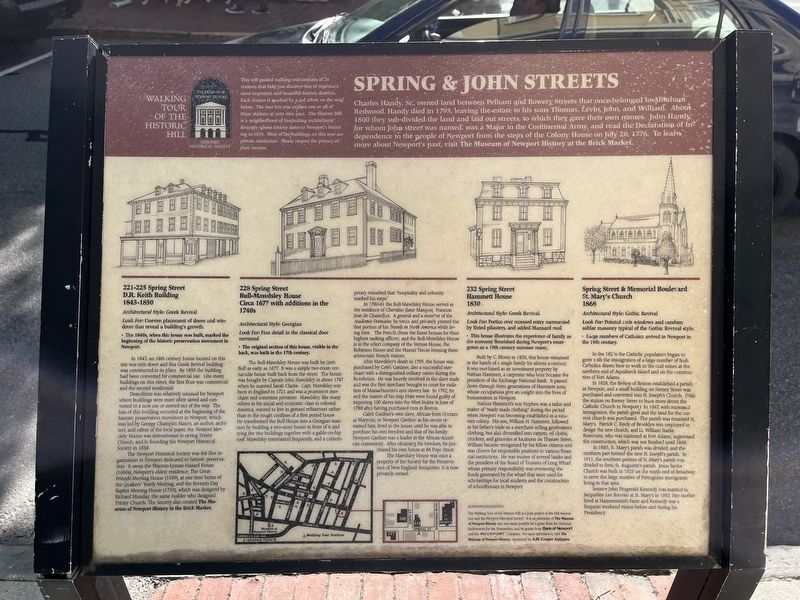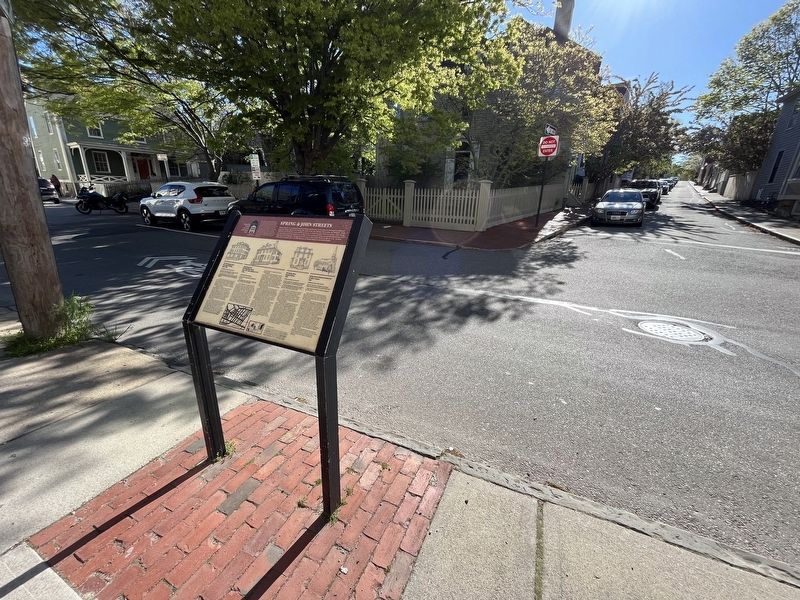Newport in Newport County, Rhode Island — The American Northeast (New England)
Spring & John Streets
Walking Tour of the Historic Hill
— The Museum of Newport History, Newport Historical Society —
Charles Handy, Sr., owned land between Pelham and Bowery Streets that once belonged to Abraham Redwood. Handy died in 1793, leaving the estate to his sons Thomas, Levin, John, and William. About 1800 they sub-divided the land and laid out streets, to which they gave their own names. John Handy, for whom John street was named, was a Major in the Continental Army, and read the Declaration of Independence to the people of Newport from the steps of the Colony House on July 20, 1776. To learn more about Newport's past, visit The Museum of Newport History at the Brick Market.
221-225 Spring Street
D.R. Keith Building
1843-1850
Architectural Style: Greek Revival
Look For: Uneven placement of doors and windows that reveal a building's growth.
• The 1840s, when this house was built, marked the beginning of the historic preservation movement in Newport.
In 1843, an 18th century house located on this site was torn down and this Greek Revival building was constructed in its place. By 1856 the building had been converted for commercial use. Like many buildings on this street, the first floor was commercial and the second residential.
Demolition was relatively unusual for Newport where buildings were more often saved and converted to a new use or moved out of the way. The loss of this building occurred at the beginning of the historic preservation movement in Newport, which was led by George Champlin Mason, an author, architect, and editor of the local paper, the Newport Mercury. Mason was instrumental in saving Trinity Church, and in founding the Newport Historical Society in 1854.
The Newport Historical Society was the first organization in Newport dedicated to historic preservation. It owns the Wanton-Lyman-Hazard House (1660s), Newport's oldest residence; The Great Friends Meeting House (1699), at one time the home of the Quakers' Yearly Meeting; and the Seventh Day Baptist Meeting House (1730), which was designed by Richard Munday, the same builder who designed Trinity Church. The Society also crated The Museum of Newport History in the Brick Market.
228 Spring Street
Bull-Mawdsley House
Circa 1677 with additions in the 1740s
Architectural Style: Georgian
Look for: Fine detail in the classical door surround.
• The original section of this house, visible in the back, was built in the 17th century.
The Bull-Mawdsley House was built by Jireh Bull as early as 1677. It was a simple two room vernacular house built back from the street. The house was bought by Captain John Mawdsley in about 1747 when he married
In 1780-81 the Bull-Mawdsley House served as the residence of Chevalier (later Marquis) Francois Jean de Chastellux. A general and a member of the Academie Francaise, he wrote and privately printed the first portion of his Travels in North America while living here. The French chose the finest houses for their highest ranking officers, and the Baull-Mawdsley House is in the select company of the Vernon House, the Robinson House and the Hunter House housing these aristocratic French visitors.
After Maudsley's death in 1795, the house was purchased by Caleb Gardner, also a successful merchant with a distinguished military career during the Revolution. He was heavily involved in the slave trade and was the first merchant brought to court for violation of Massachusetts's anti-slavery law. In 1792, he and the master of his ship Hope were found guilty of importing 100 slaves into the West Indies in June of 1788 after having purchased rum in Boston.
Caleb Gardner's own slave, African-born Occramar Marycoo, or Newport Gardner as his owner renamed him, lived in the house until he was able to purchase his own freedom and that of his family. Newport Gardner was a leader in the African-American community. After obtaining his freedom, he purchased his own house at 86 Pope Street.
The Mawdsley House was once a property of the Society for the Preservation of New England Antiquities. It is now privately owned.
232 Spring Street
Hammett Hosue
1830
Architectural Style: Greek Revival.
Look For: Portico over recessed entry surrounded by fluted pilasters, and added Mansard roof.
• This house illustrates the experience of family as the economy flourished during Newport's emergence as a 19th century summer resort.
Built by C. Bliven in 1830, this house remained in the hands of a single family for almost a century. It was purchased as an investment property by Nathan Hammett, a carpenter who later became the president of the Exchange National Bank. It passed down through three generations of Hammett sons, whose occupations give an insight into the lives of businessmen in Newport.
Nathan Hammett's son Stephen was a tailor and maker of "ready made clothing" during the period when Newport was becoming established as a summer colony. His son, William H. Hammett, followed in his father's trade as a merchant selling gentlemen's clothing, but also diversified into carpets, oil cloths, crockery, and groceries at locations on Thames Street. William became recognized by his fellow citizens and was chosen for responsible positions in various financial institutions. He was trustee of several banks and the president of the Board of Trustees of Long Wharf whose primary responsibility was overseeing the funds generated by the wharf that were used for scholarships for local students and the construction of schoolhouses in Newport.
Spring Street & Memorial Boulevard
St. Mary's Church
1868
Architectural Style: Gothic Revival
Look For: Pointed arch windows and random ashlar masonry typical of the Gothic Revival style.
• Large numbers of Catholics arrived in Newport in the 19th century.
In the 1820s the Catholic population began to grow with the immigration of a large number of Irish Catholics drawn here to work in the coal mines at the northern end of Aquidneck Island and on the construction of Fort Adams.
In 1828, the Bishop of Boston established a parish in Newport, and a small building on Barney Street was purchased and converted into St. Joseph's Church. (Visit the station on Barney Street to learn more about the Catholic Church in Newport.) In 1847, with increased immigration, the parish grew and the land for the current church was purchased. The parish was renamed St. Mary's. Patrick C. Keely of Brooklyn was employed to design the new church, and Lt. William Starke Rosencrans, who was stationed at Fort Adams, supervised the construction, which was not finished until 1868.
In 1885, St. Mary's parish was divided, and the northern part formed the new St. Joseph's parish. In 1911, the southern portion of St. Mary's parish was divided to form St. Augustin's parish. Jesus Savior Church was built in 1929 on the north end of Broadway to serve the large number of Portuguese immigrants living in that area.
Senator John Fitzgerald Kennedy was married to Jacqueline Lee Bouvier at St. Mary's in 1953. Her mother lived at Hammersmith Farm and Kennedy was a frequent weekend visitor before and during his Presidency.
Erected by Newport Historical Society.
Topics and series. This historical marker is listed in these topic lists: African Americans • Arts, Letters, Music • Churches & Religion • Colonial Era. In addition, it is included in the Former U.S. Presidents: #35 John F. Kennedy, and the Quakerism series lists. A significant historical month for this entry is June 1788.
Location. 41° 29.085′ N, 71° 18.788′ W. Marker is in Newport, Rhode Island, in Newport County. Marker is at the intersection of Spring Street and John Street, on the right when traveling south on Spring Street. Touch for map. Marker is in this post office area: Newport RI 02840, United States of America. Touch for directions.
Other nearby markers. At least 8 other markers are within walking distance of this marker. St. Mary’s Parish (about 300 feet away, measured in a direct line); Jonathan Gibbs House (about 500 feet away); Pelham Street (about 600 feet away); Peter Lee House (about 600 feet away); Serenity Inn Newport (about 600 feet away); Bells (about 600 feet away); The Hammetts Bell (about 600 feet away); Alexander Jack Jr. House (about 600 feet away). Touch for a list and map of all markers in Newport.
Additional keywords. human trafficking
Credits. This page was last revised on May 29, 2023. It was originally submitted on May 11, 2023, by Devry Becker Jones of Washington, District of Columbia. This page has been viewed 57 times since then and 12 times this year. Photos: 1, 2. submitted on May 11, 2023, by Devry Becker Jones of Washington, District of Columbia.

